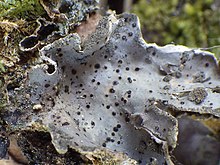tr
kırıntılardaki isimler


Abrothallus ist die einzige Gattung der einzigen Familie Abrothallaceae der Schlauchpilze, die alleine die Ordnung Abrothallales bilden.
Abrothallus-Arten leben mit ihrem Myzel eingesenkt im Wirtsthallus. somatische Hyphen färben sich mit Jod violett (amyloid) oder nicht. Die Fruchtkörper sind apothezienförmig, die aus dem Wirtscortex hervorragen. Sie sind sitzend oder teilweise eingesenkt, kugelig bis abgeflacht, oft mit einer grünlichen oder gelblichen Rindenstruktur, der Pruina. Das Excipulum ist reduziert, und besteht aus kurzen dichotom verzweigten Hyphen. Die oberste Schicht des Apotheciums (Epihymenium) ist braun- oder rotkörnig. Die Körner lösen sich normalerweise in Kalium. Das Hypothecium, das Gewebe direkt unter der Fruchtschicht ist hell- bis dunkelbraun und besteht aus länglichen Zellen, die mit einem braunen Pigment bedeckt sind. Das Hamathecium (das Gewebe zwischen den Schläuchen) besteht aus dickwandigen, ungleich dichotom verzweigten und anastomosierten, und septierten Hyphen (möglicherweise Pseudoparaphysen), manchmal leicht geschwollen am Scheitel. Das Gel der Fruchtschicht färbt sich nicht mit Jod. Die Schläuche sind bitunikat, funktionell fissitunikat (das heißt, der Schlauch fährt teleskopartig aus), breit bis schmal keulig, inamyloid und enthalten vier bis acht Sporen. Bei manchen Arten brechen diese in Teilsporen auseinander noch innerhalb des Schlauches. Die Sporen sind anfangs durchscheinend, später braun, oft warzig, mit ein, zwei oder drei Septen und unsymmetrisch in ihrer Form. Die Nebenfruchtform ist verbreitet, vom Vouauxiomyces-Typ, mit Pyknidien, schwarz, im Wirtsthallus eingesenkt oder halb eingesenkt mit einer kleinen Öffnung (Ostiolum). Die Wand der Pyknidie besteht aus einer textura angularis, also aus einem Parenchym-ähnlichen Gewebe aus dickwandigen isodiametrischen Zellen. Es sind keine Konidienträger vorhanden. Die konidienbildenden Zellen verbreiten sich durchgehend und belegen die Aushöhlung der Pyknidie. Sie sind ampullen- bis flaschenförmig und glattwandig. Die Konidien sind holoblastisch, keulig bis birnenförmig, durchscheinend, glatt oder sehr leicht stachelig, sie liegen in einem Schleim.[1]
Abrothallus-Arten leben obligat parasitisch auf Flechten. Als Wirte kommen verschiedenste Vertreter der Strauch- und Blattflechten in Frage, besonders aus den Familien Parmeliaceae und Lobariaceae, aber auch auf Arten der Familien Nephromataceae, Stereocaulaceae, Cladoniaceae, Ramalinaceae und Pannariaceae.[1] Die Gattung ist kosmopolitisch, Vertreter der Gattung wurden auf allen Kontinenten außer der Antarktis gefunden.[1]
Die Gattung Abrothallus wurde bereits 1845 von Giuseppe De Notaris beschrieben. Lange Zeit war die taxonomische Position unsicher und noch 2010 war die Gattung nur als incertae sedis innerhalb der Schlauchpilze. 2014 beschrieben Sergio Pérez-Ortega und Ave Suija die monotypische Ordnung Abrothallales mit der einzigen Familie Abrothallaceae und deren einziger Gattung Abrothallus.[2][1] Sie bilden eine Ordnung mit unsicherer Stellung innerhalb der Dothideomycetes.[3]
Zur Zeit (Stand Mai 2018) zählen folgende Arten zur Gattung:[4]
Abrothallus ist die einzige Gattung der einzigen Familie Abrothallaceae der Schlauchpilze, die alleine die Ordnung Abrothallales bilden.
Abrothallus is a genus of lichenicolous fungi. It is the only genus in the monotypic family Abrothallaceae, which itself is the sole taxon in the order Abrothallales.[2]
The genus was circumscribed by Italian botanist Giuseppe De Notaris in 1849.[3] The classification of the genus in either family or order was uncertain until molecular phylogenetic analysis revealed the group as an independent lineage in the class Dothideomycetes. Both the family and the order were circumscribed in 2013 by Sergio Pérez-Ortega and Ave Suija.[4]
In 2012 Mikhail Zhurbenko proposed the genus Epinephroma to contain E. kamchatica;[5] later analysis showed it to be the anamorph of an Abrothallus species,[6] and now Epinephroma is placed in synonymy with Abrothallus. Other synonyms are Abrothallomyces, Phymatopsis, and Pseudo-lecidea.[1]
There are several morphological characteristics help define the genus Abrothallus. These include: spherical (or nearly so) ascomata without a margin or well-defined edge that are sometimes dusted with golden or green pruina; bitunicate asci (i.e., with two functional ascal wall layers) that have four to eight ascospores; brown, 2- to 4-celled, warted asymmetric ascospores; paraphyses that are ramified-anastomosed; and the presence of an epihymenium (the uppermost layer of the hymenium) with granulose pigments that often dissolve in potassium hydroxide.[7]

Abrothallus is a genus of lichenicolous fungi. It is the only genus in the monotypic family Abrothallaceae, which itself is the sole taxon in the order Abrothallales.
Abrothallus es un género de hongos en el filo de Ascomycota. La relación de este taxón con otro dentro del mismo filo es desconocida (incertae sedis) y no ha sido colocado con certeza en ninguna clase, orden o familia.[1]
Abrothallus es un género de hongos en el filo de Ascomycota. La relación de este taxón con otro dentro del mismo filo es desconocida (incertae sedis) y no ha sido colocado con certeza en ninguna clase, orden o familia.